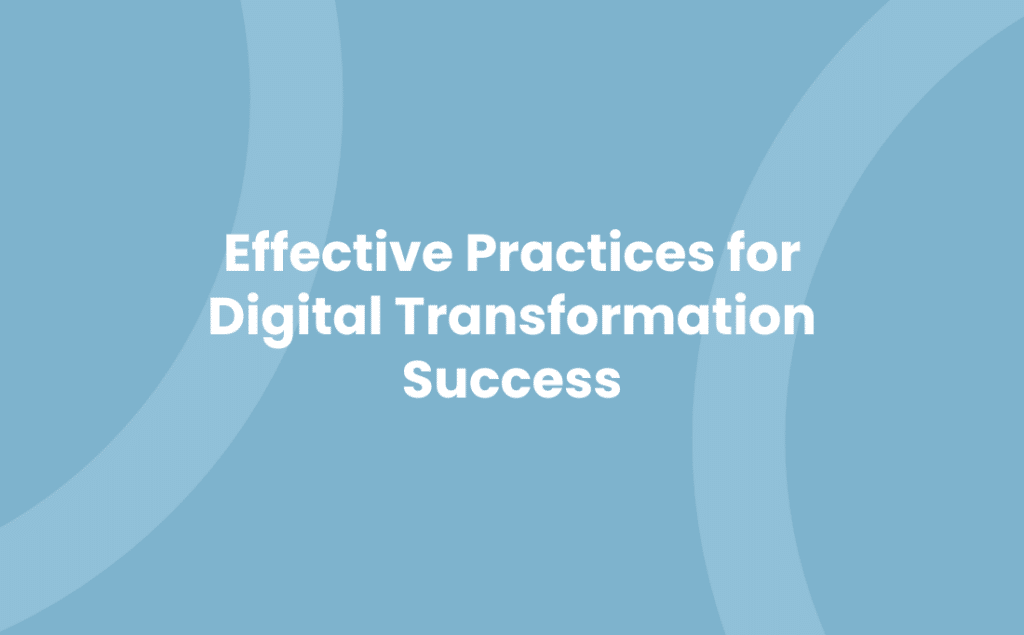Navigating the digital landscape can be a daunting task. Yet, it’s an essential journey for any modern business. In this fast-paced, technology-driven world, digital transformation isn’t just a buzzword‚ it’s a survival strategy.
There’s no one-size-fits-all approach to digital transformation. Every business has unique needs and challenges. But don’t fret, we’ve got your back. This article will explore some of the best practices to help your business ride the wave of digital transformation with confidence and ease.
Get ready to unlock new opportunities, streamline your processes and stay ahead of the game. So, let’s dive in, shall we?
Understanding Digital Transformation
In the adventure of digital transformation, illumination lies in knowledge. Grasping digital transformation enhances the calibre of your digital journey, making it efficient and rewarding. Thus, before delving into digital transformation best practices, it’s essential to decipher what digital transformation stands for and its relevance to your business.
Fundamentally, digital transformation embodies the integration of digital technology into all areas of a business. It’s a profound reformation of how businesses deliver value to customers. It isn’t just about replacing outdated tech with the latest, but about remoulding business processes and corporate culture to become agile, customer-centric and data-driven.
Perceive digital transformation as a digital compass guiding businesses through the tech quandary. It serves more than just implementing new tech solutions, it signals a shift in thought and an organisational change, which elevates efficiency, competitiveness, and innovation.
The stakes in digital transformation are far-reaching. Businesses benefit by adopting digital best practices that enable seamless operations, customer satisfaction, and taking lead in the competitive market. It reduces business costs, enhances collaboration, and facilitates decision-making grounded on data.
Grasp that digital transformation is not a destination but an ongoing journey, a continuous voyage to adapt to the ever-evolving digital innovation. It implies ruthlessly questioning existing business practices, and proactively seeking ways to improve through digital technology.
Another broad benefit of digital transformation is the prospect to create novel products and services. It enables businesses to tap the potential of advanced tech such as artificial intelligence (AI), machine learning, big data, and the Internet of Things (IoT), propelling innovation.
Even amidst the high-gain terrain, digital transformation can be a challenging endeavour. It demands comprehensive planning, resilient execution, and entire organisational commitment to the cause. It’s a complete overhaul that commands sustained effort from all aspects of your business. Therefore, being enlightened about digital transformation can make the journey less intimidating and more fruitful.
In the next section, the discussion shifts towards digital transformation best practices that optimize the process and maximize the benefits, while minimizing the risks associated with it.
Best Practices for Successful Digital Transformation
Embarking on your digital transformation journey requires strategic planning, with some essential practices playing a pivotal role in achieving success:
- Conduct Regular, Detailed Digital Audits: Carry out consistent assessments of your current digital state. This method helps to pinpoint both strengths and weaknesses in your current operation, creating a realistic perspective on your digital transformation potential.
- Focus on Customer Experience: In the realm of digital transformation, customer-focused initiatives reign supreme. Keep your customers’ needs at the forefront of your digital strategies, enabling the creation of an enhanced, personalised experience.
- Data-Driven Decision Making is Essential: Place significant emphasis on data. Data analysis provides real-time insight into your business performance, customer behaviour, and market trends. Use these insights to guide your digital transformation strategy.
- Adopt Agile and Lean Methodologies: Agile methods foster flexibility and responsiveness to change, both vital in navigating the ever-evolving digital world. On the other hand, lean helps eliminate waste and streamline your processes for utmost efficiency.
- Push for Organisational Change: Encourage a culture that is open to change and continuous learning. To fully grasp the benefits of digital transformation, your team must possess a digital mindset.
- Partner with the Right Technology Providers: Form alliances with technology providers that can deliver tailored, robust solutions to cater to your unique requirements. Partnering with the right people reduces complexities and eases your digital transformation journey.
- Implement Security Measures: An often-overlooked aspect of digital transformation is security. As you introduce more digital components into your operation, the risk of data breaches increases. Meticulously design a robust security framework to protect your digital assets.
These digital transformation best practices act as a roadmap to guide your digital transformation journey. By adopting these practices, you position your business in the heart of the digital landscape, ready to seize any opportunity that comes your way.
Role of Leadership in Digital Transformation
Leaders play a critical role in guiding digital transformation. Driving a digital shift doesn’t merely entail using new technologies. It requires reshaping the entire organisation’s mindset and culture. The onus of making this shift lies heavily on leadership.
Key responsibilities of leaders in digital transformation include setting the vision, fostering a digital culture, and empowering employees. Courage and comfort in uncertainty are characteristics vital for leaders in this digital journey.
- Setting the Vision: Leadership starts by defining a clear, concise vision for digital transformation. Leaders set the overall direction, identifying which technologies best align with the business’s strategic objectives.
- Fostering a Digital Culture: A digital-first mindset across the organisation isn’t just essential, it’s a must. By promoting curiosity, innovation, and a willingness to take calculated risks, leaders can foster a culture that embraces change. This openness resonates throughout the organisation, encouraging creativity and engagement among employees.
- Empowering Employees: Amidst digital changes, employees might feel overwhelmed. Leaders play a crucial role here. By offering adequate training and resources, leaders can help employees adapt, stressing the importance of each person’s role in driving digital success.
- Courageous Leadership: Stepping into the unknown is part-and-parcel of digital transformation. Leaders must show an appetite for calculated risk-taking and be willing to experiment and fail. It’s through iterations, trials, and occasional failures that true digital innovation happens.
- Leading by Example: Actions often speak louder than words. By actively using digital practices, leaders can demonstrate their commitment to the digital journey, setting a strong example for the rest of the organisation.
In essence, successful digital transformation relies heavily on leadership. Whether it’s setting the vision, fostering a digital culture, empowering employees or being bold in the face of uncertainty, leaders act as the north star guiding these digital best practices. Your leadership can indeed be a game-changer in the digital transformation journey! Remember, as a leader your role goes beyond implementing technology. You’re shaping the future, one digital step at a time.
Investment in Technology and its Impact on Digital Transformation
Investing in the right technology plays a crucial role in successful digital transformation. It’s like the fuel for your digital vehicle, powering your organisation’s progress in today’s digitised world. It goes beyond the simple adoption of digital tools and requires an in-depth understanding of how these tools can deliver value to your customers and improve operational efficiency.
For example, with Machine Learning, an organisation can process vast amounts of data and derive actionable insights. Simultaneously, integrating IoT devices into the business model can open up opportunities for remote monitoring, predictive maintenance, and smart operations, driving efficiency.
However, a mere investment in technology doesn’t guarantee digital transformation success. It’s vital to align that investment with your business strategy and understand its potential impact. Mere adoption of buzz-worthy technologies without a strategic direction often leads to wastage of resources and little transformative improvement.
You ask, what’s the impact of wisely invested technology? Firstly, it enables data-driven decision-making. For instance, business intelligence tools allow organisations to leverage their data and gain insights that inform strategic business decisions. This optimises processes, reduces costs, and maximises customer satisfaction.
Secondly, it enhances customer experience. Technological advancements, like AI-driven chatbots, deliver seamless customer service, building trust and loyalty. Efficient customer service aids in keeping businesses competitive, a nod towards digital best practices.
Finally, striking the right balance between maintaining essential operational systems and investing in innovative technology results in a modern, agile business model. Few can argue against the assertion, the agility gained from successful digital transformation best practices makes business more adaptable and competitive. An organisational agility, given the constant evolution of the digital landscape, is priceless.
Just remember, technology is a tool, and digital transformation concerns more how you wield that tool rather than the tool itself. Strategised, thought-out investments in technology can be a formidable driving force, pushing your business towards previously inaccessible horizons.
Case Studies of Successful Digital Transformation
Discover concrete examples of digital transformation best practices in action from notable success stories in the business world.
Case Study 1: ASOS
ASOS, the British online fashion retailer, stands as a paragon for effective digital transformation. Recognising the paradigm shift from physical to online shopping, ASOS swiftly adopted a digital-first business model. To prioritise customer experience, ASOS invested in implementing AI to offer a personalised experience to their customer base. For instance, their ‘Fit Assistant’ tool utilises ML algorithms to provide personalised size recommendations. This move to a customer-centric digital business model fostered a notable uptick in customer satisfaction and revenue.
Case Study 2: Walgreens
Look at Walgreens, the American pharmaceutical giant, offering a lesson in two significant digital transformation best practices – a focus on customer experience and data-driven decision-making. They launched ‘Find Care Now’, a digital platform that efficiently connects patients to healthcare services. This initiative significantly improved the customer experience by providing quick access to care. Additionally, leveraging data analytics, they could optimise operational efficiency and forecast market trends, thereby fortifying their position in the industry.
Case Study 3: Domino’s Pizza
Domino’s Pizza offers an enticing example of a digital chameleon in the food industry. To stay apace with rapidly changing consumer expectations, Domino’s incorporated a digital strategy, enabling customers to order pizzas through various platforms like Twitter, Alexa, or via their smart devices. Their visionary ‘AnyWare’ campaign is a testament to their adaptable integration of digital transformation. A clear acceleration in online sales validated their decisive digital switch.
Case Study 4: LEGO
LEGO, the revered toy brand, breathed new life into their business model following an effective digital transformation journey. They enhanced their customer touchpoints by building immersive digital experiences like LEGO Tower mobile game and LEGO Life social media platform for kids. This fusion of real-world play with digital innovation expanded their audience reach and re-established LEGO in the hearts of young and adult fans alike.
Embrace their digital pathway writings as a rich compass to navigate your own journey. Always remember to tailor your transformation in line with your institutional ambition, ensuring maximum impact and longevity.
Mistakes to Avoid during Digital Transformation
Despite digital transformation’s looming imperative, numerous companies tend to stumble in executing their digital strategy. With an understanding of digital transformation best practices, it’s equally essential to pinpoint common pitfalls that could sabotage your digital progression.
- Obfuscating Business Goals: The first misstep involves losing sight of your business objectives. Companies often chase after the latest technology trends, letting them steer the digital initiatives. Yet in reality, digital solutions and tools should support your business aims, becoming the accelerator, not the driver.
- Neglecting the Human Element: Principally focusing on technology while overlooking the need for cultural change is another downfall. Nurturing a digital culture, building digital dexterity among employees, and encouraging an open-minded, adaptive mindset are vital steps in your digital journey, often neglected due to an excessive tech-centric focus.
- Minimal Customer Focus: Redefining customer experience is at the heart of digitisation. A mistake many make is just “digitising” existing processes without leveraging digital capabilities to introduce innovative, customer-centric solutions. Use digital best practices to innovatively remodel processes, enriching customer engagement and experience.
- Underestimating the Importance of Data: Despite the buzz around data-driven decisions, businesses often overlook data’s potential in transforming operations. Failure to collect, interpret, and leverage data can sabotage the advancement of digital endeavours.
- Rushing Digital Transformation: Transformations are time-intensive, requiring meticulous planning and implementation. A rushed approach can lead to suboptimal results, where gradual, incremental changes often provide a more robust digital framework.
- Lack of Continual Evaluation and Improvements: Remember, digital transformation doesn’t end with the project’s completion‚ it’s an ongoing process. Failing to continually evaluate and refine your digital strategy can result in outdated systems and ineffective processes.
Understanding and avoiding these mistakes is a critical part of your digital transformation journey. By aligning your digital goals with your business objectives, prioritising people and culture, keeping a keen customer focus, utilising data, and taking a gradual, continually improving approach, you’ll be better prepared to navigate the complexities of your digital transformation effectively.
Conclusion
You’ve now got a solid grasp of the best practices for digital transformation. Remember, it’s all about agility, customer orientation, and making decisions based on data. Don’t forget the importance of digital audits, improving customer experience, and aligning technology with your business strategies. Steer clear of common pitfalls like losing sight of your goals, ignoring the human factor, and rushing the process. It’s vital to keep evaluating and improving your strategies. By keeping these key points in mind, you’re well-equipped to embark on a successful digital transformation journey. Stay focused, be patient and keep your goals in sight. Your digital future awaits you.


